- Welcome to Metal Type Forum.
Metal Type: Home | Library | Forum | Free Ads | Store
Posted by Dave Hughes
- August 28, 2008, 02:10:38 PMPlenty of Aussies on here, Arthur!
We've even got two Australian Moderators!
We've even got two Australian Moderators!

Posted by Arthur Johnson
- August 28, 2008, 04:58:01 AMIt's good to see another aussie posting to this list. At Gulgong Pioneers Museum we have just got our C4 Intertype going during the past week, our Lino Mechanic Gary Penfold who worked at the old Telegraph and then News Ltd in Sydney has been great getting our linecasters up and running. We have a battery of 6 machines. Our C3 Intertype (American) is a good runner. We also have an Electron,
Model 78 (hope to have it running soon), 48 and a Model 15. Plus we have a 48 and a C4 for spares. We also have a Ludlow and Elrod.
Print machines we have a 1869 Albion by Harrild & Sons, Furnival and Chandler & Price Platens plus a Wharfedale, Vertical Miehle and a Heidelberg Platen, plus all the good gear to go with it a full working hot metal and letterpress print shop.
PS I have a C4 Inter and a 1929 Ludlow plus a 10x15 C&P Platen in my backyard print shop. Plus a bit of (horror) small offset.
Arthur in Australia.
Model 78 (hope to have it running soon), 48 and a Model 15. Plus we have a 48 and a C4 for spares. We also have a Ludlow and Elrod.
Print machines we have a 1869 Albion by Harrild & Sons, Furnival and Chandler & Price Platens plus a Wharfedale, Vertical Miehle and a Heidelberg Platen, plus all the good gear to go with it a full working hot metal and letterpress print shop.
PS I have a C4 Inter and a 1929 Ludlow plus a 10x15 C&P Platen in my backyard print shop. Plus a bit of (horror) small offset.
Arthur in Australia.
Posted by Mechanic
- June 02, 2007, 12:18:41 PMThe pot control on the Model 31 is a Micro-Therm temperature control for both the mouthpiece and the crucible.The machine in the picture has a Hyraquadder. It appears to a manual as the electronic Hydraquadder has the control buttons on the right hand side of the keyboard. The Mechanical quader is on a Model 29.
Posted by rag451
- April 24, 2007, 03:21:55 AMI may blind anyone within fifty feet, but I sure am glad I take lots of pictures...


Posted by Dan Williams
- April 23, 2007, 11:30:00 PMIn hind sight (and it has been quite awhile) I regret seeing that old model A go. It did not fit the Intertype manual, and was not a reflection of the standard Intertype (as far as knifeblock and keyboard go). That odd knifeblock is as clear to me as yesterday.
Keep in mind that Intertype initially was American and that the earliest models were produced and distributed thoughout the Americas prior to manufacture in Great Britain.
As you infer, English Intertypes were pretty much the same as their US counterpart. But German, English and American Linotypes are as different as it gets.
I am sure that Intertype had to accomodate the "reality of sales", and you see it in their parts books. They resold rebuilt linotypes (I think as "X" intertypes -- Linotype I think did the same as "L" machines) There are numerous "old style" parts that were updated on those machines. And yes, look at the streamlined base on the post war intertypes and various high-speed refinements to accomodate teletypesetting.
Regarding the Thompson, you can see its yellow profile adjacent to the Supercaster. I believe that Dave may have a whole picture.
The local typeshops here in Houston, TX during the 20s to 60s (Granum & Company, Heavin & Hannah) had small monotype departments. Typically a single Lanston monotype composition caster and keyboard, and possibly a Giant Caster and/or Thompson.
Not very many printers were familiar with monotype systems here in the US, and those numbers fell drastically in the early seventies. I only know about them because we happened to have an odd collection and were comparatively anachronistic for that time.
Dan
Keep in mind that Intertype initially was American and that the earliest models were produced and distributed thoughout the Americas prior to manufacture in Great Britain.
As you infer, English Intertypes were pretty much the same as their US counterpart. But German, English and American Linotypes are as different as it gets.
I am sure that Intertype had to accomodate the "reality of sales", and you see it in their parts books. They resold rebuilt linotypes (I think as "X" intertypes -- Linotype I think did the same as "L" machines) There are numerous "old style" parts that were updated on those machines. And yes, look at the streamlined base on the post war intertypes and various high-speed refinements to accomodate teletypesetting.
Regarding the Thompson, you can see its yellow profile adjacent to the Supercaster. I believe that Dave may have a whole picture.
The local typeshops here in Houston, TX during the 20s to 60s (Granum & Company, Heavin & Hannah) had small monotype departments. Typically a single Lanston monotype composition caster and keyboard, and possibly a Giant Caster and/or Thompson.
Not very many printers were familiar with monotype systems here in the US, and those numbers fell drastically in the early seventies. I only know about them because we happened to have an odd collection and were comparatively anachronistic for that time.
Dan
Posted by intertypeman
- April 23, 2007, 07:20:08 PMThanks for posting those piccies. Great stuff! They all seem to be Monotype or Linotype though.
I knew that Linotype & Machinery Ltd had taken over the UK Intertype hot metal business after Harris Intertype gave up on it and had shut the Slough factory down - so the last 2 Linotypes to be built new in the UK were actually existing machines reconditioned to factory specification using new parts by Mike Kirby of Linecasting Machinery Ltd (now at Whitstable, Kent, UK, but not sure if he was already located there then) in 1985 under contract to L&M, while the last two UK Intertypes were built the same way by him for, and using parts supplied by, the Linotype factory at Altrincham in 1986. I understand that Mike is the last full-time professional linecaster engineer in the UK who can still recondition machines to factory spec, though he is a general printing machinery engineer nowadays, as he'd starve if he was only doing linecasters. I understand that Brian Russell of the British Printing Society's Shropshire branch is a retired linecaster engineer too, and that a retired former Intertype assembly specialist from the Slough factory gave a lot of help to a BPS member in the Berkshire area in sorting out poblems with his Intertype a year or so ago. How many people do we still have in the UK with amateur and professional linecaster engineering skills, and where are they?
Lovely pictures, but no picture of the Thompson caster? Of course, the business was taken over by Lanston Monotype, but I understand that they kept producing them until the very end.
Monotypes and Thompsons aren't linecasters, but they are certainly hot metal machines - wasn't this site called the hot metal site in its previous incarnation? - and they certainly produce metal type. Do we have enough Forum members interested in them, to have a chatroom for afficionados of casting machines that produce individual types?
Re that strange Intertype Model A that Dan mentioned, the point about the Intertype that made them superior in their own way to the Linotype was that the A, B and C were the same machine, the letter indicating whether they had 1, 2 or 3 magazines, and Intertype made a big thing out of the modular standardisation of their machines, claiming that any part would fit any standardised Intertype machine that had ever been produced, even though old and new parts might look quite different.
Apart from the difference between mould depths between US and UK machines that seems to have originated in machinery being available in the UK when production started in the original Manchester factory that would allow a lower shoulder to be used, with less risk of ink inadvertently transferring to the job off the shoulder as well as the face of the slug, the Intertype was standardised on both sides of the big ditch too, whereas UK and US model ranges had significant variations between models even before the UK went entirely its own way with the Model 48, roughly 70 years ago.
As a result, Intertype instruction books, whether the single volume or the 4-part version, and the parts manuals (unless they are very early ones that only cover the A, B and/or C) are universally applicable regardless of the model or country of origin, and they are still readily available in the UK, whereas instruction books and parts books for UK Linotypes are far more specific to particular models and their variants, you can't rely on a part from one model being interchangeable with the same part from another model, and US documentation is generally not relevant to UK models.
Maybe that modular standardisation explains the Harris Intertype Model C that I found last month, with a very late serial number, fitted with the "New Streamlined Intertype" square base and the "New Streamlined Intertype" Model C3 arrangement of front-loading magazines. Maybe an old C that had been factory-reconditioned to as-new specification, using standard C3 parts where Model C parts were no longer available from stock? Would that make sense?
Which makes me wonder if that strange Model A that Dan menions was either a very early production line example, or possibly even one of the very few handcrafted prototype machines that were manufactured to break ino the market, before the poduction line was set up to manufacture the Model A in quantity. As I recall, the A was the only model available to start with, and was then made available as the B (with 2 magazines) or as the C (with 3), as the demand built up.
Tony
I knew that Linotype & Machinery Ltd had taken over the UK Intertype hot metal business after Harris Intertype gave up on it and had shut the Slough factory down - so the last 2 Linotypes to be built new in the UK were actually existing machines reconditioned to factory specification using new parts by Mike Kirby of Linecasting Machinery Ltd (now at Whitstable, Kent, UK, but not sure if he was already located there then) in 1985 under contract to L&M, while the last two UK Intertypes were built the same way by him for, and using parts supplied by, the Linotype factory at Altrincham in 1986. I understand that Mike is the last full-time professional linecaster engineer in the UK who can still recondition machines to factory spec, though he is a general printing machinery engineer nowadays, as he'd starve if he was only doing linecasters. I understand that Brian Russell of the British Printing Society's Shropshire branch is a retired linecaster engineer too, and that a retired former Intertype assembly specialist from the Slough factory gave a lot of help to a BPS member in the Berkshire area in sorting out poblems with his Intertype a year or so ago. How many people do we still have in the UK with amateur and professional linecaster engineering skills, and where are they?
Lovely pictures, but no picture of the Thompson caster? Of course, the business was taken over by Lanston Monotype, but I understand that they kept producing them until the very end.
Monotypes and Thompsons aren't linecasters, but they are certainly hot metal machines - wasn't this site called the hot metal site in its previous incarnation? - and they certainly produce metal type. Do we have enough Forum members interested in them, to have a chatroom for afficionados of casting machines that produce individual types?
Re that strange Intertype Model A that Dan mentioned, the point about the Intertype that made them superior in their own way to the Linotype was that the A, B and C were the same machine, the letter indicating whether they had 1, 2 or 3 magazines, and Intertype made a big thing out of the modular standardisation of their machines, claiming that any part would fit any standardised Intertype machine that had ever been produced, even though old and new parts might look quite different.
Apart from the difference between mould depths between US and UK machines that seems to have originated in machinery being available in the UK when production started in the original Manchester factory that would allow a lower shoulder to be used, with less risk of ink inadvertently transferring to the job off the shoulder as well as the face of the slug, the Intertype was standardised on both sides of the big ditch too, whereas UK and US model ranges had significant variations between models even before the UK went entirely its own way with the Model 48, roughly 70 years ago.
As a result, Intertype instruction books, whether the single volume or the 4-part version, and the parts manuals (unless they are very early ones that only cover the A, B and/or C) are universally applicable regardless of the model or country of origin, and they are still readily available in the UK, whereas instruction books and parts books for UK Linotypes are far more specific to particular models and their variants, you can't rely on a part from one model being interchangeable with the same part from another model, and US documentation is generally not relevant to UK models.
Maybe that modular standardisation explains the Harris Intertype Model C that I found last month, with a very late serial number, fitted with the "New Streamlined Intertype" square base and the "New Streamlined Intertype" Model C3 arrangement of front-loading magazines. Maybe an old C that had been factory-reconditioned to as-new specification, using standard C3 parts where Model C parts were no longer available from stock? Would that make sense?
Which makes me wonder if that strange Model A that Dan menions was either a very early production line example, or possibly even one of the very few handcrafted prototype machines that were manufactured to break ino the market, before the poduction line was set up to manufacture the Model A in quantity. As I recall, the A was the only model available to start with, and was then made available as the B (with 2 magazines) or as the C (with 3), as the demand built up.
Tony
Posted by Dave Hughes
- April 20, 2007, 05:40:27 PMQuote from: Dan Williams on April 20, 2007, 03:36:52 PM
Dave probably will get onto us for all the Linotype talk (as this is the INTERTYPE chat)
 Dave is turning a blind eye
Dave is turning a blind eye 
Posted by Dan Williams
- April 20, 2007, 03:36:52 PMThanks for the confirmation on the Linotronic, Robert. Regarding that model 31; it had manually controlled hydraquadder, but the model 29 definitely had a mechanical quadder. Look at the second elevator articulation at the back on the photo of the mechanical quadder machine; only mixer machines (25, 26, 29, 30, 35, 36, etc), Elektrons and Comets had that.
Also, the model 31 with Linotronic must have been a very late machine. Its outrigged pump arm is the same as our model 35 that the family used to have -- that, and the Linotronic heater, likely dates it to the mid nineteen sixties. Too bad we didnt get its serial number to confirm.
(Robt emailed me its serial - 70054 - thats January to June 1962)
Dave probably will get onto us for all the Linotype talk (as this is the INTERTYPE chat) but I have an Intertype I have been helping on so I will post photos on that soon, next time I go visit it. That other machine (Intertype)needs vice automatic adjustment and pot pump safety adjustment. Intertypes pot pump safety is much different from Linotypes scheme of right jaw activation. Better?
Also, the model 31 with Linotronic must have been a very late machine. Its outrigged pump arm is the same as our model 35 that the family used to have -- that, and the Linotronic heater, likely dates it to the mid nineteen sixties. Too bad we didnt get its serial number to confirm.
(Robt emailed me its serial - 70054 - thats January to June 1962)
Dave probably will get onto us for all the Linotype talk (as this is the INTERTYPE chat) but I have an Intertype I have been helping on so I will post photos on that soon, next time I go visit it. That other machine (Intertype)needs vice automatic adjustment and pot pump safety adjustment. Intertypes pot pump safety is much different from Linotypes scheme of right jaw activation. Better?
Posted by rag451
- April 19, 2007, 07:00:51 PMIt's a Linotronic Control M II. I'll post a picture later.
The manual quadder is on a Model 31, by the way.
The manual quadder is on a Model 31, by the way.
Posted by Dan Williams
- April 19, 2007, 05:41:45 PMI may have misidentified that electric pot. Linotronic? Hmm. Thats the later version of heater control post-dating the Microtherm. Linotronics have an electron tube that gradually adjusts heater intensity, unlike the Microtherm which relies on pressure activated high-current microswitches. Used on lots of Elektrons, but is that what we are seeing here? I thought I saw it labelled on the top panel, but now the memory isnt clear. Any comments?
Posted by rag451
- April 19, 2007, 02:42:56 PMDan was one excited boy! 
Can you tell our friends what else we saw?
Here are a couple more pictures which I took last week...



Can you tell our friends what else we saw?
Here are a couple more pictures which I took last week...


Posted by Dave Hughes
- April 19, 2007, 11:39:28 AMDan has added the following pictures:
English Super Caster
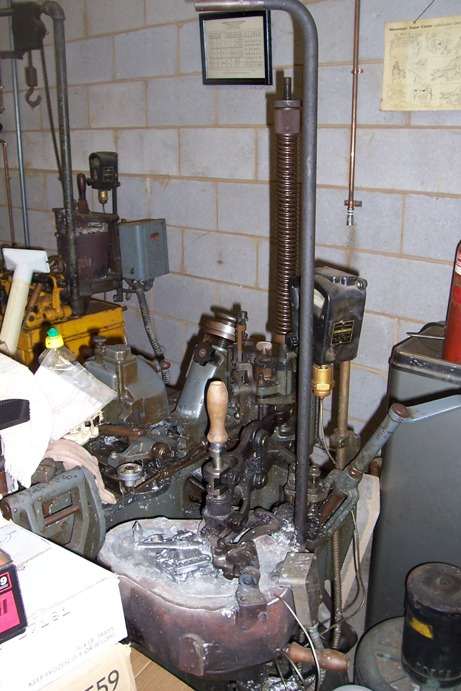
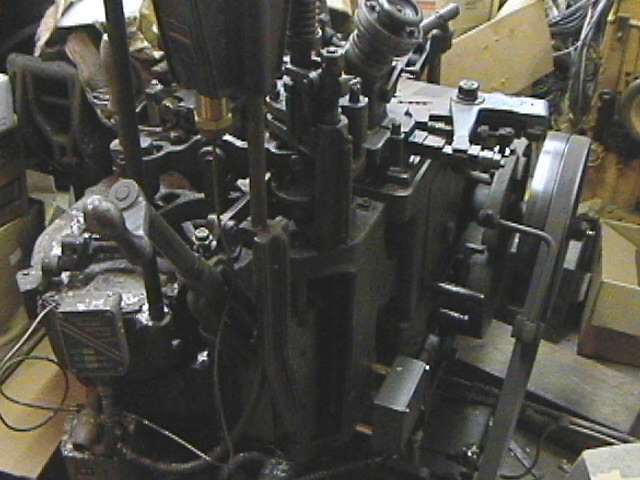
Lanston Composition Caster
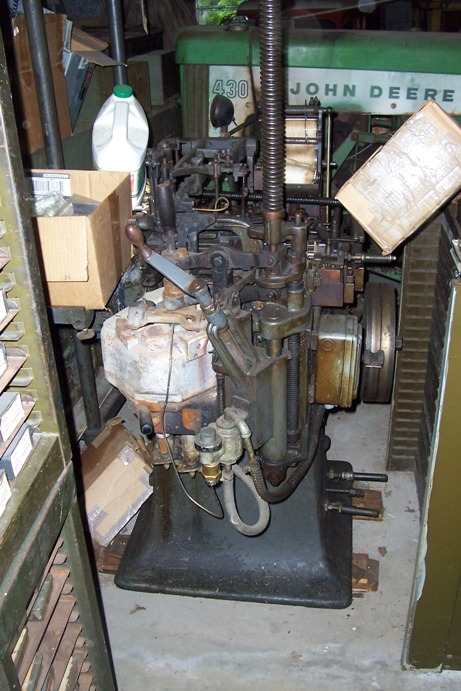
Model 29 Mechanical Quadder
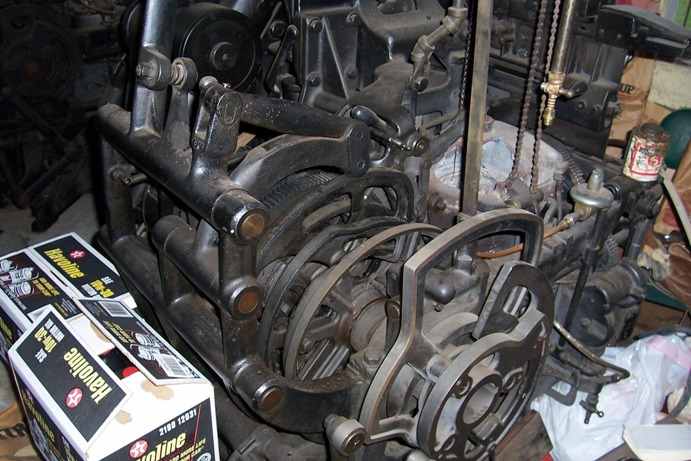
Model 31 Linotronic Heater
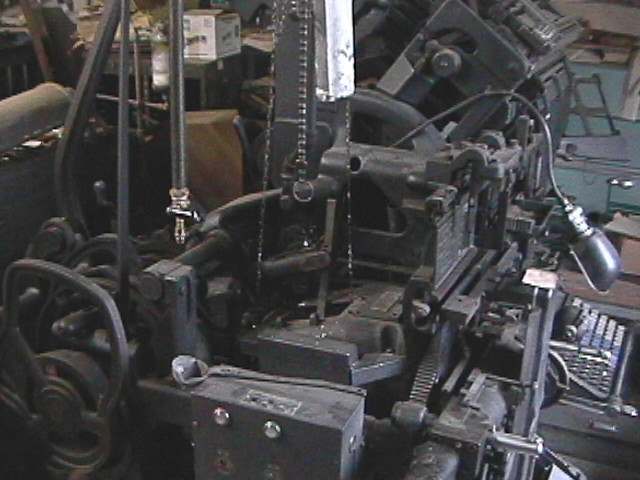
English Super Caster


Lanston Composition Caster

Model 29 Mechanical Quadder

Model 31 Linotronic Heater

Posted by Dan Williams
- April 18, 2007, 10:16:29 PMQuote from: intertypeman on April 04, 2007, 04:48:54 PM
HELP!
I found the Linotype Chat section, but I don't want to chat about Linotypes, I want to chat about a rather odd Intertype that I don't quite understand. It seems to be something that it didn't ought to be, which is a hybrid between a Model C and a C3.
Tony the not-a-Linotype-man - but I'd just love to have a Typograph or a Thompson caster to play with!
Guess what?
I saw a Thompson Caster, a Giant Caster, a Material Maker, a Super Caster, and about half dozen Lanston composition casters just this past weekend. Can't tell you where. But ask Robert Griffith-he was with me. It was the first time I had ever seen a Thompson or a Super Caster. Breathtaking.
Dan
Posted by Dave Hughes
- April 11, 2007, 02:43:06 PMYou only had to ask! 

Posted by intertypeman
- April 10, 2007, 03:41:10 PMGo on - give us a cosy corner of our own to chat in, so we can tell each other how much better Intertypes are without upsetting those Linotype fellas!
Printers' Tales - Over 30 stories from the pre-digital age. Buy now on Amazon/Apple Books
☛ Don't miss our illustrated newsletters. Click here to see examples and subscribe. ☚

